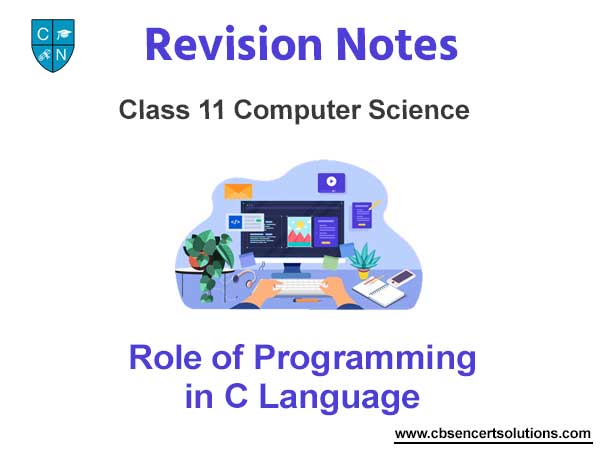Please refer to Role of Programming in C Language Class 11 Computer Science notes and questions with solutions below. These revision notes and important examination questions have been prepared based on the latest Computer Science books for Class 11. You can go through the questions and solutions below which will help you to get better marks in your examinations.
Class 11 Computer Science Role of Programming in C Language Notes and Questions
Marks questions
Question 1 Which symbol is used to terminate stements in the C Language Program?
Answer
Semicolon (;)
Question 2 How many main functions can be used in the C language program?
Answer
One
Question 3 Which symbols are used to define the body of a function?
Answer
{ }
Question 4 Which header file is used to setup Math library?
Answer
math.h
Question 5 Which format symbol of print f() function is used to represent the signed integer value.
Answer
%d
Question 6 Which symbol is used to represent the null character?
Answer
\0
Question 7 C is a which level of language?
Answer
Middle Level
Question 8 Which symbol is used to end each Statement of C language?
answer
Semicolon (;)
Question 9 Which character is represented using zero (0) value?
Answer
Null Character (\0)
Question 10 Which character is represented using \t in C Language?
Answer
tab
Question 11 Write an example of compile time directive.
Answer
#define
Marks Questions
Question 1 Write the limitations of C Language.
Ans: C Language has the following limitations:
1. It is a case-sensitive language.
2. C Language has no control over data.
3. C Language is difficult to learn.
4. This language is not based on the principles of Object Oriented Programming (OOP)
Q:2 Write about the application areas of C language.
Ans: Application areas of C language are given below:
1. It is used in developing application programs
2. It is used to build the Commercial Applications
3. It is used to develop System Software’s.
4. It is used to develop Graphical Applications.
5. It is used to build hardware drivers.
Q:3 What are the Preprocessor Directives?
Ans: Some activities are carried out during compilation of the C programs. Those statements which are used to carry
out these activities are called Pre-Prcessor directives. Preprocessors are implemented before compilation.
Preprocessor directives always begin with # (hash) symbol. Some of the common examples of pre-rpcessor
directives aer #define, #include. Following examples shows how to use these directives:
#includde<stdio.h>
#define pl 3.14
Q:4 What do you mean by global declarations?
Ans: Declaration of those variables and functions whose existence is present outside main function or other user defined functions is called global declarations. Following code shows the example for global declaration of variables:
#include<stdio.h>
int a=5; //global declaration of variable
void main()
{
printf(“\n%d”,a);
}
In the above example program, variable a is the global declaration which can be used anywhere in the program.
Q:5 Write the general structure of C Program.
Ans: The general structure of C program is as follows:
Preprocessor directives
global declarations;
Void main()
{
local declarations;
statements;
}
user define declarations;
Q:6 What are the Fundamental Steps of C program implementation?
Ans: Fundamental Steps of C program implementation are given below:
1. Create Program File
2. Save the Program
3. Compile the C Program
4. Link the system library functions
5. Execute/Run the program.
Q:7 What are the stages of Compilation and Linking?
Ans: Following diagram shows the different stages of compilation:

Q:8 Write the difference between print f() and scan f() function.
Ans: Both of these functions are library functions which are present in the stdio.h header file. Main differences
between these functions are given below:

Q:9 Why print f() and scan f() functions are called Input / Output functions?
Ans: The function print f() is called output function while the scan f() function is called input function, because print f()
function is used to show the formatted output on the monitor screen and scan f() function is used to get data from
the user using keyboard. Both of these functions are present in the stdio.h header file.

Q:10 What is the purpose of & in the scan f() function.?
Ans: The symbol & is the address operator. This operator represents the memory address of the variable where
input data will be stored. The function scan f() gets data from the keyboard and store it at the memory address of the
variable given in the scan f() function. For example;
scan f(“%d”, &a);
In this example, symbol & represents the memory address of variable ‘a’.

We hope the above Role of Programming in C Language Class 11 Computer Science are useful for you. If you have any questions then post them in the comments section below. Our teachers will provide you an answer. Also refer to MCQ Questions for Class 11 Computer Science


